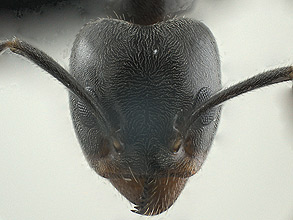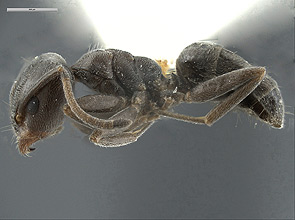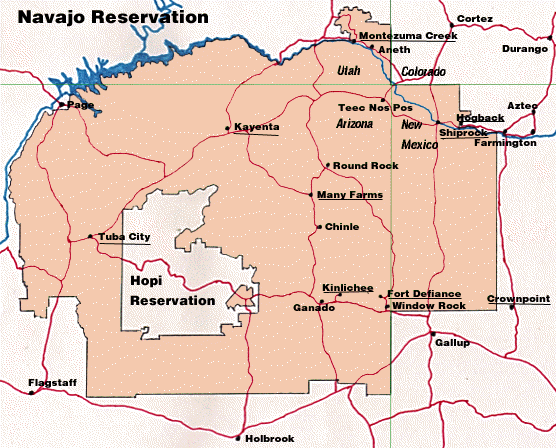- Identification
- Polymorphic, concolorous dark brown workers. The body is covered with a dense pubescence, a feature that partially explains the common name for ants in this genus - "velvety tree ants." It is possible to separate Liometopum luctuosum from Liometopum apiculatum by the presence of a metanotal suture that breaks up the dorsal mesosomal outline, the short and relatively sparse standing hairs on the top of the pronotum and their dark coloration. The largest workers of Liometopum apiculatum are distinctively larger than the largest sized luctuosum workers.
- Biology
- Liometopum luctuosum nest under rocks, decaying logs and at the base of large trees. Colonies can be large and their abundant workforce can be quite noticeable due to their long foraging trails and constant activity. Foraging can be persistent throughout the day and night. This species is closely related and shares much in common with its co-occuring congener Liometopum apiculatum. Liometopum luctuosum is usually found at higher elevations (> 2000 m) but does occur in suitable habitat in lower elevation sites.
- additional biology notes...
- Distribution
- Range
- United States and Mexico. Washington state, south to Central Mexico, east to western Texas.
- Navajo Reservation Records
- Species records being processed.
- Additional Notes
- This species can be found in habitats with sagebrush, oaks, Ponderosa pine, Douglas fir, and in riparian habitats found at higher elevations. Liometopum luctuosum is an aggressive ant and the excitable workers will stream out of the nest, emitting a strong odor, and quickly swarm upon anything located near the nest entrance when a colony is disturbed.
- They can form long and very busy trails that are used for foraging or to connect segments of their polydomous nest. Established trail routes can persist for many years (Shapley 1920). Foraging columns can also be located under the ground and litter, surfacing underneath ground level objects such as rocks and downed wood. Colonies are rarely investigated because both finding and excavating a nest can be difficult. Foraging trails often disappear into inaccessible holes (e.g. around the roots at the base of a tree) or into a cavity that is more a satellite location where some workers may congregate rather than a part of the nest. Workers disappearing under a rock that can be flipped over, for example, are typically found to be using the covering object to make their way into one of their underground trails. In some cases these cavities will contain numerous workers, but no brood, and digging reveals there are no additional nest chambers nearby. When the main section of the nest is found, or suspected to be located, it may be situated in a tree bole or under a large rock.
- Both their odor and aggressive nature make them a potential nuisance when they do, albeit relatively rarely, settle in or around human structures. Reproductive flights occur in June and July, at least in the southwest.
- Description
- Original Combination - Liometopum apiculatum subsp. luctuosum - W.M. Wheeler (1905).
- Worker described by W.M. Wheeler (1905):
- Male described by Forel (1914):
- Literature
- Del Toro, I., J. A. Pacheco, and W. P. Mackay. 2009. Revision of the Ant Genus Liometopum (Hymenoptera: Formicidae). Sociobiology. 53:299-369.
- Forel, A. 1914. Einige amerikanische Ameisen. Deutsche Entomologische Zeitschrift. 1914:615-620. PDF
- Mallis, A. 1941. A list of the ants of California with notes on their habits and distribution. Bulletin of the Southern California Academy of Sciences. 40:61-100.
- Wheeler, W. M. 1905. The North American ants of the genus Liometopum. Bulletin of the American Museum of Natural History. 21:321-333. PDF
- A note about these publications. The literature cited here is not meant to be an exhaustive list of papers published about this species.
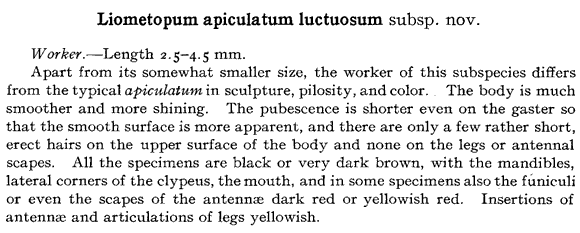
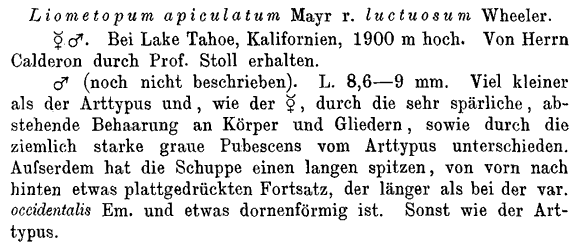
Page authored by David Lubertazzi and Gary Alpert
